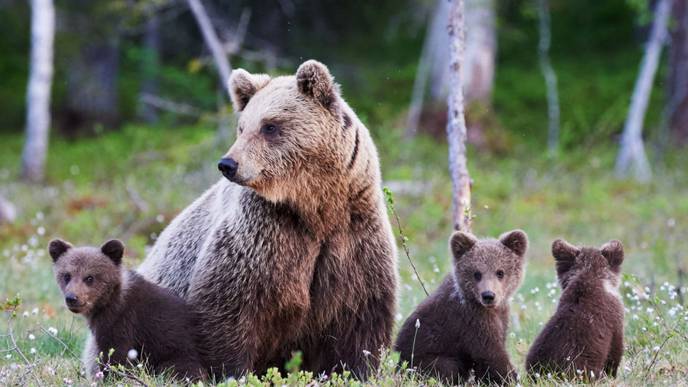Global Study Finds While Humans Sheltered in Place, Wildlife Roamed

07/15/2023
MISSOULA – While humans sheltered in place during the COVID-19 pandemic, wild animals took the opportunity to roam spaces typically avoided by wildlife, according to a study published last month in Science. Photos quickly emerged of wild goats spotted on the city streets of Wales and coyotes touring downtown San Francisco, yet evidence explaining this phenomenon was sparse.
Dr. Mark Hebblewhite, professor of ungulate habitat ecology at the University of Montana, joined an international research team of 175, led by Dr. Marlee Tucker – an ecologist at Radboud University in the Netherlands – in analyzing global data from 2,300 land mammals from around the world tracked by GPS devices.
In locations with strict lockdown policies, animals (from elephants to giraffes to bears and deer) traveled longer distances during the lockdown period. In highly populated areas, mammals moved less frequently and were closer to roads than they were before the pandemic. These results demonstrate how human activities constrain animal movement and what happens when those activities cease.
“The fact that human activity is affecting wildlife on a day-to-day basis across the planet is not new,” said Hebblewhite, who works in the W.A. Franke College of Forestry and Conservation. “But this study exemplifies the global impact human activity has on wildlife everywhere.”
Researchers tracked data from 43 different species of mammals, Hebblewhite said. Surprisingly, the biggest variation in the study was really driven by variation in human lockdowns.
What about Montana? A place where land mammals have the luxury of miles and miles of wild spaces and where humans flocked to escape the lockdown measures in bigger cities?
While some states and countries, such as Europe, had more stringent lockdown requirements – researchers called this the COVID lockdown stringency index – the effects were different in Montana, where there was an increase in human activity in open spaces around cities like Missoula.
“But even in places like Montana and the Western U.S., we saw changes in human behavior,” Hebblewhite said. “People drove less, and there was less human activity at the typical times of day we see animals and humans being active.”
While researchers were able to understand animal behavior during the pandemic by studying the GPS data of 3,200 collared species, they didn’t have comparably detailed data about human responses.
“What is it about humans? What do we mean by human activity?” Hebblewhite said. “Humans build infrastructure: highways, railways, golf courses, trails. It’s the physical footprint of human development – the human footprint index.”
During COVID, that footprint didn’t change, but the amount of people on it did.
Researchers discovered three different wildlife responses to the worldwide lockdown:
- On average, animals moved every hour less than prior to lockdown measures because they no longer had to avoid humans as much on a daily basis. Humans are predictably busier on roads, trails and highways in the mornings before 9 a.m. and the evenings after 5 p.m. In California, for example, mountain lions didn’t have to avoid urban areas as much because there was less human activity.
- Animal migration increased. Researchers found that animals made long-distance movements more frequently. While on sabbatical in Italy, Hebblewhite studied European brown bears and predicted where the bears might cross highways in connectivity corridors. “Bears during COVID increased long-distance movements in those corridors as we predicted,” he said. “Moving between valleys, dispersing, migrating – those things did increase when human activity decreased. They didn’t have to avoid humans and could make riskier movements.” During the pandemic, bears in Italy used corridors they had never used before because humans were locked in their homes.
- Animals were found closer to roads and in areas heavily used by humans. “Our interpretation is consistent with the first piece on hourly movements. People were no longer driving on roads and highway traffic was down. The roadway was still there, but animals were no longer afraid of it. They moved closer to highways and railways and began crossing them more during the day rather than at night,” he said. Researchers found this to be the case across the planet and among all 43 species.
“This is a global analysis of 2.5 thousand GPS animals across 43 species. The result is strong,” Hebblewhite said. “As strong as you can get in science with animals.”
The study supports the assumption that human activity has profound impacts on animals across the planet, and its impact was recently demonstrated after last summer’s flooding in Yellowstone. The event caused humans to once again shelter in place and cease activity in the busy national park. The results from the study allowed researchers and park managers to make exact predictions of wildlife behavior during that time.
“In Banff, based on studies like this, the national park closed down Highway 1A in the spring when wildlife is restricted to lower elevations,” Hebblewhite said. “They closed the highway because previous studies like this showed negative effects of human activity on wildlife during that time of year.”
In Montana, the study could support road closures during elk hunting season in order to increase elk survival and have more bull elk for harvesting, he adds.
“Now, we can look at this and think of human-restricted activity in order to help people managing elephant activity in Africa,” Hebblewhite said. “It’s a strong paper that demonstrates the global effect of humans on wildlife. It illustrates the impacts of human activities even in our most protected national parks. Anyone who goes to Yellowstone in summer spends most of the time thinking about how to avoid traffic. If you’re thinking about it, then wildlife is thinking about it too.”
###
Contact: Mark Hebblewhite, professor, W.A. Franke College of Forestry and Conservation, 406-243-6675, mark.hebblewhite@umontana.edu.

Facebook Comments